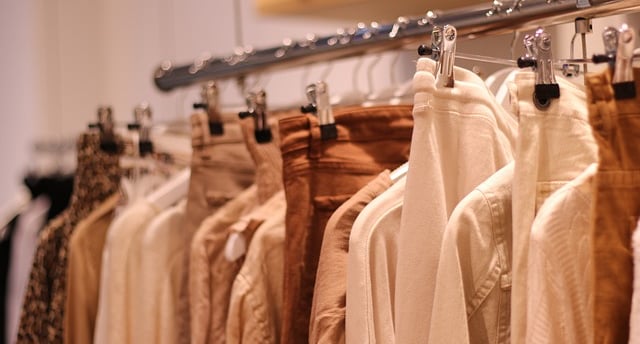Don't Skirt the Issue
Is Fast Fashion as harmful as Fast Food?
1/20/20253 min read


It’s my first blog but buckle up buttercup … it’s a big one and for that, I need a soapbox 😉
Fashion - I love it but never followed it like a religion. Instead, I've put faith in my ability to know what suits me and developed my own style. These days, I'm more conscious of the effects of fast fashion and its effect on the planet but I do wonder, if I was twenty-something, would I even care about the pollution the fashion industry contributes to or would I only care that I looked hot on a Friday night and was wearing the latest fad? When I was twenty-something, fast fashion didn't exist and neither did throw-away prices, but now clothes are ridiculously cheap as are the materials they're made of, making them disposable, unlike in my day. I think about the 90s and the Joseph catsuit that cost me a whole month's salary. It was beans on toast for the month but the sacrifice was worth it because, in my wardrobe, I had a treasure that would last me a very long time.
Over the last few years, here in the UK, we’ve been experiencing significant challenges with textile waste contributing to environmental degradation and resource depletion. One of the reasons I created SCUSSH was to address this issue and personally do something about it. By recycling and repurposing textiles into practical soft furnishings I’m doing my bit. Of course, I am only one person and can only make a minuscule difference; but it is still a difference, and this makes me part of the solution, not the problem. That's a benefit to society AND the planet.
Statistics in the UK (at the time of writing)
The volume of textile waste in the UK is horrific - approximately 1.45 million tonnes of used textiles were generated in 2022. 650,000 tonnes of that were diverted for reuse and recycling, and 421,600 tonnes were exported. Binned by everyday households were around 711,000 tonnes of used textiles - 84% of that was incinerated and 11% was sent to landfill. I’m not great at maths but even I can see that nearly half of all used textiles in the UK were being disposed of in general waste bins. Break that down and we’re looking at around 35 items per person per year.
If the data out there is correct, then each UK resident chucks out approximately 3.1 kg of textiles every year, leaving 1.7 kg to landfill. Sadly, we are the fourth-largest producer of textile waste in Europe (not officially Europe but you know what I mean) and we generate around 206,456 tonnes of textile waste each year – that is MAHOOSIVE.
Environmental Impact (at the time of writing)
The disposal of textiles in landfills has alarming environmental consequences. The decomposition of materials, especially synthetic fibres, releases greenhouse gases like methane, which contributes to climate change. Add to that the fact that dyes and chemicals used in textile production seep into the soil and groundwater causing pollution. With the explosion of online shopping and the crazy cheap prices from places like SHEIN and TEMU, the fashion industry is responsible for 20% of global water waste, and textile dyeing is the second-largest water polluter worldwide.
Benefits of SCUSSH
Using textiles and materials that have been discarded and transforming them into pouffes and floor cushions contributes to several environmental advantages. Like:
Waste Reduction: Recycling textiles decreases the volume of the waste sent to landfills and incinerators - this lessens the environmental hazards of waste.
Resource Conservation: Repurposing textiles protects natural resources by reducing the demand for new raw materials, i.e., producing a single cotton shirt takes around 2,700 litres of water which is equivalent to 2.5 years of drinking water for one person … that’s just one shirt FFS! By recycling we take the strain off water resources and decrease energy consumption.
Pollution Prevention: Recycling textiles helps lower landfill emissions and reduces pollution from manufacturing processes.
Economic Opportunities: The textile recycling industry offers employment in sorting, processing, and manufacturing which contributes to the economy.
Promote Textile Recycling – Practical Steps
Here are a few suggestions on how we, as individuals or together in communities, can take proactive steps:
Donation: It's a no-brainer isnt it - give clothing and textiles to charity shops. This gives them a longer lifecycle and supports people in need.
Upcycling: Take up creative projects that transform old textiles into new things. For instance, you could turn them into reusable shopping bags because we need to quit the plastic!
Support Sustainable Brands: Choose products from companies and small business owners like me, that prioritise recycled materials and sustainable practices in their manufacturing processes.
Community Initiatives: Participate in or organise local textile recycling drives and workshops to raise awareness and encourage collective action.
Conclusion
The mounting pressure of this issue in the UK necessitates immediate and sustained action. By recycling textiles and repurposing them into practical items we can radically reduce environmental impact, protect valuable resources, and foster a sustainability culture. Collective efforts at the individual, community, and industry levels are essential to drive positive change and that ensures a healthier planet for future generations.
I’ll step down from my soapbox now and promise that all future blogs will be less because as they say, less is more.
